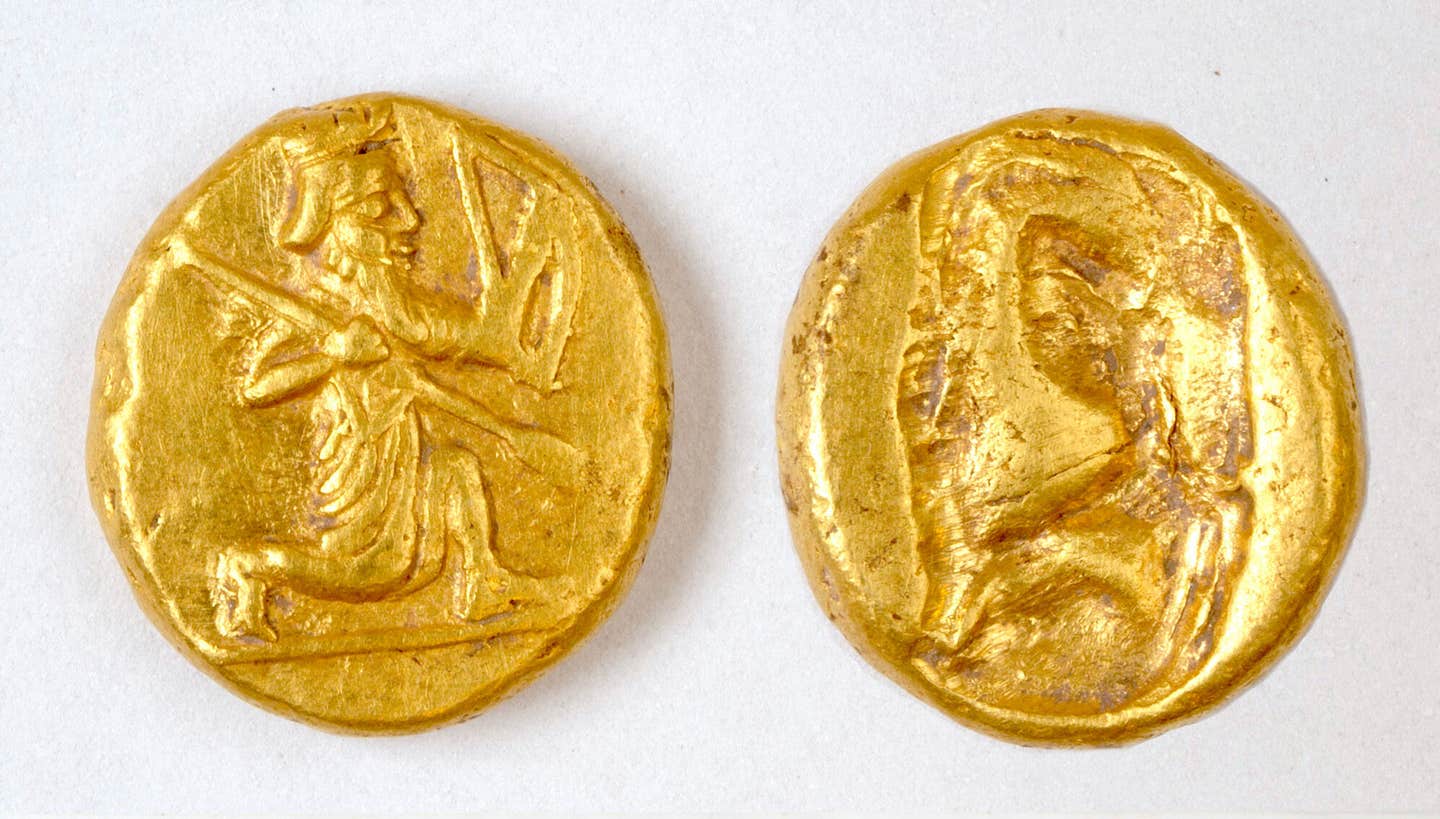Persian gold coin discovery sheds new light on Greek life
Researchers have uncovered a hoard of gold coins, likely used to pay mercenary troops, buried in a small pot in the ancient Greek city of Notion in western Turkey.

Archaeologists discovered a pot of gold Persian coins, called darics, at the ancient city of Notion in Turkey. The coins show a figure of a kneeling archer, the characteristic design of the Persian daric, a type of gold coin issued by the Persian Empire and probably minted at Sardis, 60 miles northeast of Notion, according to Christopher Ratté, a professor of ancient Mediterranean art and archaeology at the University of Michigan and director of the Notion Archaeological Project. (CREDIT: Notion Archaeological Project, University of Michigan)
In a remarkable discovery, a team of researchers led by an archaeologist from the University of Michigan unearthed a significant hoard of gold coins in the ancient Greek city of Notion, located in western Turkey. The hoard, believed to have been used as payment for mercenary troops, was found buried in a small pot. This find, dating back to the fifth century B.C., sheds new light on the history and chronology of the Persian daric, a type of gold coin issued by the Persian Empire.
The coins, which bear the image of a kneeling archer, are characteristic of the Persian daric, a coin likely minted at Sardis, a city situated approximately 60 miles northeast of Notion. According to Christopher Ratté, a University of Michigan archaeologist and professor of ancient Mediterranean art and archaeology, these coins provide a valuable insight into the timeline of Persian coinage. Ratté, who also serves as the director of the Notion Archaeological Project, emphasized the rarity of such a find in a controlled archaeological excavation, noting that "no one ever buries a hoard of coins, especially precious metal coins, without intending to retrieve it. So only the gravest misfortune can explain the preservation of such a treasure."
The Persian daric was minted from the late sixth century B.C. until the conquest of the Persian Empire by Alexander the Great in 330 B.C. While the design of the coins remained consistent, with only minor stylistic differences, researchers have long sought to arrange these coins in a chronological sequence. One of the key contributions of this newly discovered hoard is that it provides an independently dated reference point, anchored by other artifacts found alongside the coins. Ratté explained that this discovery offers a firm date that will help refine the chronology of Persian coinage.
Andrew Meadows of Oxford University, formerly a curator of coins at the British Museum and the American Numismatic Society, highlighted the importance of the hoard’s archaeological context. If accurately established, it could allow for more precise dating of Achaemenid gold coinage. Meadows described the find as "spectacular" and "of the highest importance."
The excavation at Notion, which began in 2022, revealed the hoard in 2023. The Turkish Ministry of Culture and Tourism has since allowed the discovery to be made public, though the coins remain in Turkey.
Related Stories
Notion's best-preserved remains date to the Hellenistic period, between the third and first centuries B.C., but the excavation of a large courtyard house in the city center suggests earlier habitation. Pottery fragments from the fifth century B.C. were found incorporated into the foundations of this house, indicating a long history of occupation. In July 2023, the hoard of coins was discovered beneath one area of the courtyard, carefully buried in a small pot in the corner of a room. The structure where the hoard was found lies beneath the Hellenistic house, suggesting the coins were stored for safekeeping but never recovered.
Ratté noted that the value of the hoard would have been substantial in its time, with a single daric equating to a soldier's pay for one month. The coins likely served as payment for mercenary troops, potentially linked to military operations around Notion. This possibility is supported by ancient accounts of military activities in the region, where Notion found itself at the crossroads of Persian and Athenian influence.
Most known hoards of darics have been discovered not through scientific excavations but by looters, who often disregard the historical context of their finds. Ratté likened an archaeological find without contextual information to "a person suffering from amnesia—a person without memories." In contrast, the Notion hoard, with its well-documented archaeological context, offers invaluable insights. Researchers have a strong foundation to speculate on when the hoard was deposited, most likely in the late fifth century B.C.
Notion was incorporated into the Persian Empire along with other Greek cities on the west coast of Turkey in the mid-sixth century B.C. Although it was briefly freed from Persian rule in the early fifth century B.C., it was later reintegrated into the empire in the early fourth century B.C. and remained under Persian control until Alexander the Great's conquest in 334 B.C.
Throughout the fifth century B.C., Notion experienced a series of military conflicts, as it lay on the border between Persian and Athenian spheres of influence. The conflicting loyalties of Notion's inhabitants are vividly depicted in accounts by ancient historians. For instance, between 430 B.C. and 427 B.C., a group of Persian sympathizers from the nearby city of Colophon, supported by mercenaries, occupied part of Notion. In response, an Athenian general named Paches attacked and killed the pro-Persian mercenaries, expelling the sympathizers and reorganizing Notion under Athenian control.
This turbulent period could explain the deposition and eventual loss of the hoard. However, other events, such as the decisive naval battle in 406 B.C. between Athens and Sparta or the Great Satraps' Revolt in the 360s B.C., may also be connected to the hoard's origins.
The ongoing Notion Archaeological Project is sponsored by the University of Michigan in collaboration with Sinop University, with authorization from the Turkish Ministry of Culture and Tourism. The associate director, Hazar Kaba, an associate professor of archaeology at Sinop University, is also a key figure in the project.
As the new field season at Notion begins, researchers are hopeful that further excavation will clarify the archaeological context of the hoard. The coins, now in the care of the Ephesus Archaeological Museum in Turkey, are expected to provide additional evidence regarding their date, function, and the broader historical implications of this extraordinary find.
Note: Materials provided above by The Brighter Side of News. Content may be edited for style and length.
Like these kind of feel good stories? Get The Brighter Side of News' newsletter.
Joshua Shavit
Science & Technology Writer | AI and Robotics Reporter
Joshua Shavit is a Los Angeles-based science and technology writer with a passion for exploring the breakthroughs shaping the future. As a contributor to The Brighter Side of News, he focuses on positive and transformative advancements in AI, technology, physics, engineering, robotics and space science. Joshua is currently working towards a Bachelor of Science in Business Administration at the University of California, Berkeley. He combines his academic background with a talent for storytelling, making complex scientific discoveries engaging and accessible. His work highlights the innovators behind the ideas, bringing readers closer to the people driving progress.



